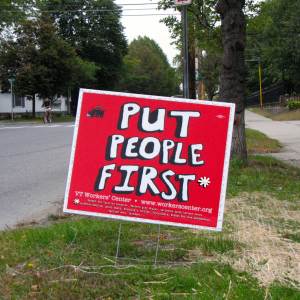 Signs with the slogan Put People First are common in Vermont, especially in election years. The signs give one a hazy sense of advocating for the little guy struggling against some faceless corporation. Such slogans are vague and undefined and few people take the time to try to understand their exact meaning. To clarify their meaning, we must look at the issues that the organizations that post the signs stand for.
Signs with the slogan Put People First are common in Vermont, especially in election years. The signs give one a hazy sense of advocating for the little guy struggling against some faceless corporation. Such slogans are vague and undefined and few people take the time to try to understand their exact meaning. To clarify their meaning, we must look at the issues that the organizations that post the signs stand for.
Organizations that put up these signs are often advocates of “economic rights,” not in the proper sense of rights such as those of property and contract, but in the sense used by President Roosevelt in the 1930s. They include “rights” to health care, a living wage, education, housing, freedom from unfair competition, and a secure retirement. All such “rights” are values that must be provided by someone, or the money to buy them must be provided. Someone either gives you food or gives you money to buy food, for example. In their most essential form, such “economic rights” are simply the “right” to money, which must be provided by others if you do not have it.
Proper rights must be able to be universally applied. For example, the right to life is a proper right. If you have the right to your life then your neighbor must have the same right and therefore you cannot freely kill him. However, you would have the right to defend yourself from his attack as such an attack would be a violation of your rights. With this proper view of rights we can easily see that “economic rights” cannot be universal and therefore are not proper rights. If the right to money, which must be provided by others if you do not have it, were proper then those who are made to provide it must also have the right to money, an obvious contradiction. In the end, and contrary to all proper rights, one group must be sacrificed to another.
The decision as to which groups will be sacrificed and which will receive the benefit of the sacrifice is not a constant, but varies with changes in the political climate and the particular “right” involved. It could be from the “rich” to the “poor” In the form of minimum wages and welfare payments, to mortgage holders from all other tax payers in the form of mortgage interest tax deductions, to patients from doctors in the form of below market reimbursement rates, or to the elderly from the young in the form of Social Security. The forms and combinations are nearly endless but the essential element is that the individual, as an individual and not part of some pressure group, is put last, sacrificed to the pressure group of the day.
In part 2 I’ll take a look at how these groups actually view human beings, or people as an actual whole.

Pingback: Threat from Environmentalists - Lessons from the Garden - Order From Chaos